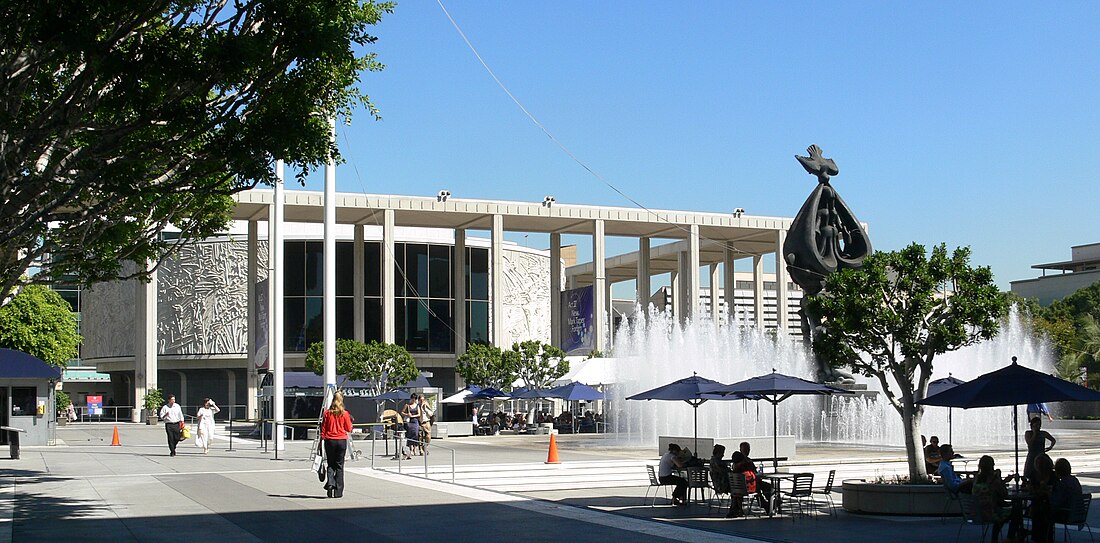Top Qs
Timeline
Chat
Perspective
New Formalism (architecture)
Late modernist style of architecture From Wikipedia, the free encyclopedia
Remove ads
New Formalism is an architectural style that emerged in the United States during the mid-1950s and flowered between the 1960s and 1970s. Buildings designed in that style exhibited many Classical elements including "strict symmetrical elevations"[1] building proportion and scale, Classical columns, highly stylized entablatures and colonnades. The style was used primarily for high-profile cultural, high tech, institutional and civic buildings. Edward Durrell Stone's New Delhi American Embassy (1954), which blended the architecture of the east with modern western concepts, is considered to be the symbolic start of New Formalism architecture.[2]



Remove ads
Origins and principles
Summarize
Perspective
Common features of the New Formalism style include:
- Use of traditionally rich materials such as travertine, marble, and granite or man-made materials that mimic their luxurious qualities;
- Buildings usually set on a podium;
- Designed to achieve modern monumentality;
- Embraces classical precedents, such as arches, colonnades, classical columns, and entablatures;
- Smooth wall surfaces;
- Delicacy of details;
- Formal landscape; use of pools, fountains, and a sculpture within a central plaza.[2]
Born as a rejection of the rigidity of architectural modernism, New Formalism attempted to wed Classical architectural with concrete's ability to take on fluid, expressive forms to create new shapes such as umbrella shells, waffle slabs and folded plates. Early innovators of this style, such as Edward Durell Stone, believed that International Style's focus on function was not enough and that buildings must put a greater or equal value on aesthetic beauty. In 1958, Stone famously called for a re-examination of classical and ancient artistic traditions in a Time magazine interview in which he stated: "What we need is to put pure beauty into our buildings".[3]
Stone's rejection of the glass facades in favor of arabesque grilles are clear to see in the U.S. Embassy in New Delhi, India, opened in 1959. In addition to grilles or screens instead of glass and exterior walls made of exotic material, New Formalist structures have a carefully organized hierarchy of space, and an emphasis is placed on the structural grid of the building.[4]
Remove ads
Notable architects
Notable examples



- 2 Columbus Circle, New York City (1964)
- Ahmanson Theater, Los Angeles, California (1967)
- Beinecke Rare Book & Manuscript Library, New Haven, Connecticut (1963)
- Cambridge Tower, Austin, Texas (1965)
- Dorothy Chandler Pavilion, Los Angeles, California (1964)
- Equitable Building, Los Angeles, California (1969)
- Istiqlal Mosque, Jakarta, Indonesia (1978)
- John F. Kennedy Center for the Performing Arts, Washington, D.C. (1971)
- Koffler particle accelerator, Rehovot, Israel (1976)
- Lincoln Center for the Performing Arts, New York City (1962–1969)
- Los Angeles County Museum of Art, Los Angeles, California (1965)
- McGregor Memorial Conference Center, Detroit, Michigan (1958)
- Memphis International Airport, Memphis, Tennessee (1963)
- Northwestern National Life Building, Minneapolis, Minnesota (1965)
- Original World Trade Center, Lower Manhattan, New York City (1966)
- Pacific Science Center, Seattle, Washington (1962)
- San Diego Sports Arena (now Pechanga Arena), San Diego, California (1966)
- Teacher Retirement System of Texas Headquarters, Austin, Texas (1973)
- The Forum, Inglewood, California (1967)
- Weber County Main Library, Ogden, Utah (1968)
References
Wikiwand - on
Seamless Wikipedia browsing. On steroids.
Remove ads
